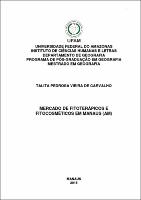| ???jsp.display-item.social.title??? |


|
Please use this identifier to cite or link to this item:
https://tede.ufam.edu.br/handle/tede/4636Full metadata record
| DC Field | Value | Language |
|---|---|---|
| dc.creator | Carvalho, Talita Pedrosa Vieira de | - |
| dc.creator.Lattes | http://lattes.cnpq.br/5799619278885992 | por |
| dc.contributor.advisor1 | Costa, Reinaldo Corrêa | - |
| dc.contributor.advisor1Lattes | http://lattes.cnpq.br/2202003231659719 | por |
| dc.date.issued | 2015-06-03 | - |
| dc.identifier.citation | CARVALHO, Talita Pedrosa Vieira de. Mercado de fitoterápicos e fitocosméticos em Manaus (AM). 2015. 190 f. Dissertação (Mestrado em Geografia) - Universidade Federal do Amazonas, Manaus, 2015. | por |
| dc.identifier.uri | http://tede.ufam.edu.br/handle/tede/4636 | - |
| dc.description.resumo | Este trabalho trata do mercado de fitoterápicos e fitocosméticos em Manaus (AM). Os objetivos são: analisar os produtos da sociobiodiversidade do mercado de fitoterápicos e fitocosméticos em Manaus, identificar as potencialidades do mercado e analisar as matrizes do processo produtivo com base na natureza. O trabalho foi desenvolvido com base na relação sociedade e natureza, utilizando os conceitos de: biodiversidade, sociobiodiversidade, tecnologia, formação socioespacial, política territorial e geossistema. Foram utilizados dados primários, obtidos por meio de entrevistas com camponeses, funcionários de instituições relevantes à pesquisa e empresários, e dados secundários, via levantamento bibliográfico e participação em eventos. O mercado estudado é polarizado pela cidade de Manaus, onde estão os centros políticos e econômicos do estado. O mercado começou a se expandir em Manaus há aproximadamente quinze anos, como resultado de políticas territoriais e de ideologias (ambiental e da saúde). Os produtos da sociobiodiversidade identificados como mais importantes para as indústrias do mercado em Manaus são: andiroba, copaíba, cupuaçu, buriti e crajiru. Suas fases de transformação são: 1) matéria-prima in natura (plantas medicinais ou de utilidade estética); 2) semielaborado 01 (óleo vegetal considerado bruto, com pouca tecnologia agregada); 3) semielaborado 02 (óleo vegetal considerado refinado, inserido em processos industriais e tecnológicos de maiores investimentos); e 4) produto final (fitoterápico e fitocosmético). A matéria-prima é produzida pelos camponeses por meio do cultivo ou coleta das plantas e é resultado das interações do geossistema, que se concretiza devido ao potencial ecológico das plantas que gera uma exploração biológica por grupos sociais diversos. As plantas medicinais são utilizadas tradicionalmente como parte da formação socioespacial, porém ainda se tornam necessários investimentos em pesquisas de bioprospecção e biotecnologia. | por |
| dc.description.abstract | This work deals with herbal and phytocosmetic market in Manaus (AM). The objectives are: to analyze the products of social-biodiversity of herbal and phytocosmetic market in Manaus, to identify the potential of the market and to analyze the headquarters of the production process based on nature. The study was conducted based on the relationship between society and nature, using the concepts of biodiversity, socio-biodiversity, technology, socio-spatial formation, territorial politics and geosystem. Primary data were used, obtained through interviews with farmers, employees of institutions with relevance in research and business, and secondary data, through literature and participation in events. The studied market is polarized by the city of Manaus, where there are the political and economic centers of the state. The market has begun to expand in Manaus in the last fifteen years as a result of territorial politics and ideologies (environmental and health). Products of socio-biodiversity identified as the most important for the industries of the market in Manaus are: andiroba, copaiba, cupuaçu, buriti and crajiru. Their processing stages are: 1) raw material in natura (medicinal plants or aesthetic value); 2) semi finished 01 (vegetable oil considered raw, with little added technology); 3) semi finished 02 (vegetable oil considered refined, inserted in industrial and technological processes for greater investment); and 4) final product (herbal and phyto-cosmetic). The raw material is produced by farmers through cultivation and collection of plants and it is a result of geosystem interactions, which is realized due to the ecological potential of plants generating a biological exploration by different social groups. Medicinal plants are traditionally used as part of the socio-spatial formation, but it also becomes necessary investments in research of bioprospecting and biotechnology. | eng |
| dc.description.sponsorship | CAPES - Coordenação de Aperfeiçoamento de Pessoal de Nível Superior | por |
| dc.format | application/pdf | * |
| dc.thumbnail.url | http://200.129.163.131:8080//retrieve/8714/Disserta%c3%a7%c3%a3o%20-%20Talita%20Pedrosa%20Vieira%20Carvalho.pdf.jpg | * |
| dc.language | por | por |
| dc.publisher | Universidade Federal do Amazonas | por |
| dc.publisher.department | Instituto de Ciências Humanas e Letras | por |
| dc.publisher.country | Brasil | por |
| dc.publisher.initials | UFAM | por |
| dc.publisher.program | Programa de Pós-graduação em Geografia | por |
| dc.rights | Acesso Aberto | por |
| dc.subject | Mercado de fitoterápico | por |
| dc.subject | Sociobiodiversidade | por |
| dc.subject | Fitocosméticos | por |
| dc.subject | Geossistemas | eng |
| dc.subject | social-biodiversity | eng |
| dc.subject | Geosystems | eng |
| dc.subject.cnpq | CIÊNCIAS HUMANAS: GEOGRAFIA | por |
| dc.title | Mercado de fitoterápicos e fitocosméticos em Manaus (AM) | por |
| dc.type | Dissertação | por |
| Appears in Collections: | Mestrado em Geografia | |
Files in This Item:
| File | Description | Size | Format | |
|---|---|---|---|---|
| Dissertação - Talita Pedrosa Vieira Carvalho.pdf | Dissertação - Talita Pedrosa Vieira Carvalho | 6.2 MB | Adobe PDF |  Download/Open Preview |
Items in DSpace are protected by copyright, with all rights reserved, unless otherwise indicated.




